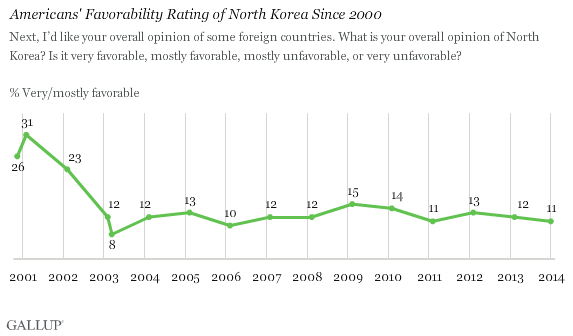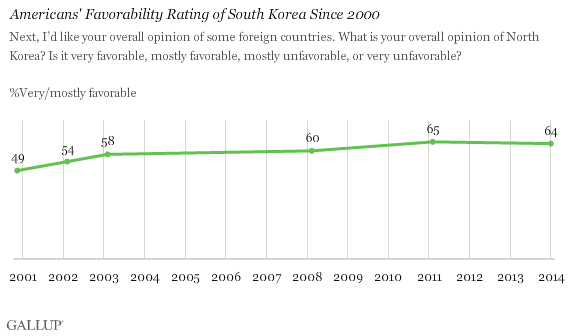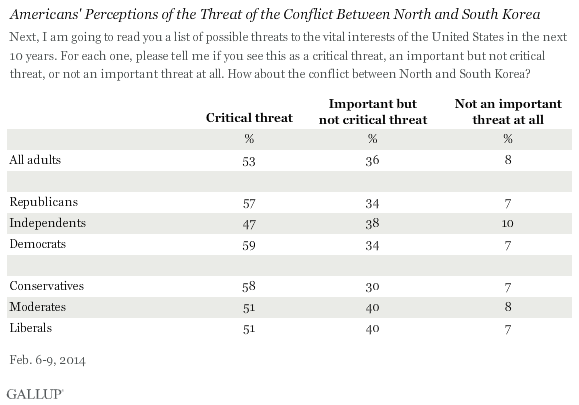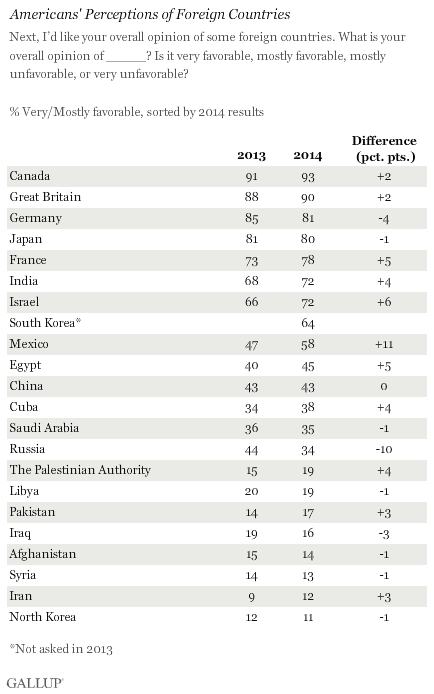PRINCETON, NJ -- Americans rate North Korea the least favorably of 22 countries rated in Gallup's 2014 World Affairs poll, with 11% having a favorable opinion of the country. North Korea took over the bottom spot from Iran, whose rating rose from 9% to 12% this year. North Korea's favorability has not exceeded 15% since 2002, consistently making it one of the lowest rated. But this is the first time since 2004 that it has been alone in last place.

North Korea's position at the bottom of the list is mainly attributable to a slight improvement in Americans' opinions of Iran. Iran had been the worst-rated country since 2004. North Korea now immediately trails Afghanistan (14%), Syria (13%), and Iran (12%). See page 2 for the full ranking of the 22 countries.
The current data come from the 2014 update of Gallup's annual World Affairs survey, conducted Feb. 6-9. The poll was conducted shortly before the United Nations announced the results of a yearlong study concluding that North Korea has committed crimes against humanity, which could lead to the arrest of the North Korean leader Kim Jong-un, as well as drive Americans' perceptions of the country even lower. Americans' opinions of the country fell sharply in 2002, when President George W. Bush labeled the country a member of the "axis of evil" in his State of the Union Address, and have not recovered.
In contrast, Americans have much more positive attitudes toward South Korea, with 64% viewing the country favorably. Americans' views of South Korea have steadily grown more positive since its initial sub-50% favorable rating in 2001.

Majority View Conflict Between North and South as a Critical U.S. Threat
The conflict between North and South Korea escalated last year after North Korea's nuclear tests prompted U.N. condemnation and the country's withdrawal from all non-aggression pacts with South Korea. More recently, the two sides have been talking, and while tensions flared over the South's refusal to cancel joint military exercises with the U.S., negotiators agreed Friday to go forward with a cross-border reunion of 200 people.
A majority of Americans, 53%, see the conflict between North and South Korea as a "critical threat" to the "vital interests of the U.S. in the next 10 years." Another 36% see the conflict as an important, but not critical threat, while 8% see it as not an important threat.
Republicans and Democrats are more likely than independents to consider the conflict as a critical threat. Conservatives are slightly more likely than moderates and liberals to view the conflict as critical.

Bottom Line
Recent coverage of North Korea in the American press has ranged from news of last year's nuclear threats and political posturing to the unusual friendship between former NBA star Dennis Rodman and Kim Jong-un, events that did nothing to improve the country's image in the American public's eyes. Americans have had an overwhelmingly unfavorable view of North Korea for many years. Even before Bush included North Korea in the "axis of evil" in 2002, roughly six in 10 Americans viewed the country unfavorably. However, by 2003, North Korea's U.S. image had soured further, and has never recovered. Today, with tensions high between North and South Korea, Americans see the conflict as a threat to vital U.S. interests.
The report of the U.N. panel, which concluded that human rights abuses have occurred in North Korea, has brought the country into the international spotlight once again, and could push its image in the U.S. even lower. Though with about one in 10 Americans giving the country a favorable rating, there is not much farther for it to fall.
Survey Methods
Results for this Gallup poll are based on telephone interviews conducted Feb. 6-9, 2014, with a random sample of 1,023 adults, aged 18 and older, living in all 50 U.S. states and the District of Columbia.
For results based on the total sample of national adults, the margin of sampling error is ±4 percentage points at the 95% confidence level.
Interviews are conducted with respondents on landline telephones and cellular phones, with interviews conducted in Spanish for respondents who are primarily Spanish-speaking. Each sample of national adults includes a minimum quota of 50% cellphone respondents and 50% landline respondents, with additional minimum quotas by time zone within region. Landline telephone and cellphone numbers are selected using random-digit-dial methods. Landline respondents are chosen at random within each household on the basis of which member had the most recent birthday.
Samples are weighted to correct for unequal selection probability, nonresponse, and double coverage of landline and cell users in the two sampling frames. They are also weighted to match the national demographics of gender, age, race, Hispanic ethnicity, education, region, population density, and phone status (cellphone only/landline only/both, cellphone mostly, and having an unlisted landline number). Demographic weighting targets are based on the most recent Current Population Survey figures for the aged 18 and older U.S. population. Phone status targets are based on the most recent National Health Interview Survey. Population density targets are based on the most recent U.S. census. All reported margins of sampling error include the computed design effects for weighting.
In addition to sampling error, question wording and practical difficulties in conducting surveys can introduce error or bias into the findings of public opinion polls.
View methodology, full question results, and trend data.
For more details on Gallup's polling methodology, visit www.gallup.com.
